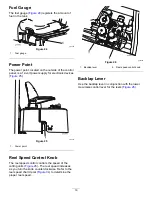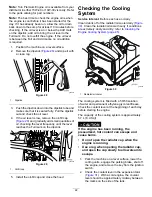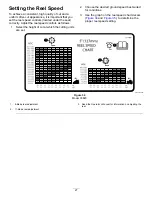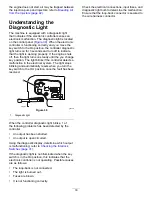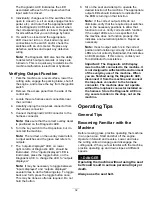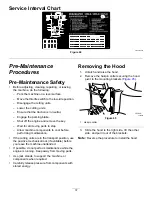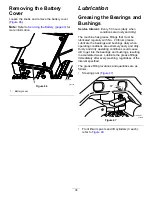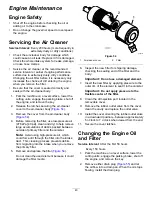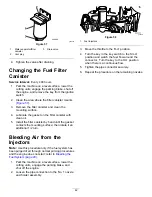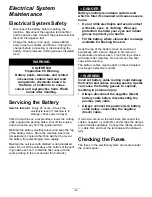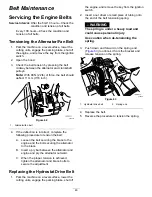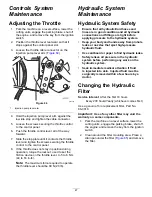
The Diagnostic ACE illuminates the LED
associated with each of the inputs when that
input switch is closed.
8.
Individually, change each of the switches from
open to closed (i.e., sit on seat, engage traction
pedal, etc.), and note that the appropriate LED
on the Diagnostic ACE blinks on and off when
the corresponding switch is closed. Repeat this
for all switches that you can change by hand.
9.
If a switch is closed and the appropriate
LED does not turn on, check all wiring and
connections to the switch and/or check the
switches with an ohm meter. Replace any
defective switches and repair any defective
wiring.
Note:
The Diagnostic ACE also has the ability
to detect which output solenoids or relays are
turned on. This is a quick way to determine if a
machine malfunction is electrical or hydraulic.
Verifying Output Function
1.
Park the machine on a level surface, lower the
cutting units, engage the parking brake, shut off
the engine, and remove the key from the ignition
switch.
2.
Remove the access panel from the side of the
control arm.
3.
Locate the wire harness and connectors near
the controller.
4.
Carefully unplug the loop-back connector from
the harness connector.
5.
Connect the Diagnostic ACE connector to the
harness connector.
Note:
Make sure that the correct overlay decal
is positioned on the Diagnostic ACE.
6.
Turn the key switch to the O
N
position, but do
not start the machine.
Note:
The red text on the overlay decal refers
to input switches and the green text refers to
outputs.
7.
The “outputs displayed” LED, on lower
right column of Diagnostic ACE, should be
illuminated. If the “inputs displayed” LED is
illuminated, press the toggle button, on the
Diagnostic ACE, to change the LED to “outputs
displayed.”
Note:
It may be necessary to toggle between
“inputs displayed” and “outputs displayed”
several times to do the following step. To toggle
back and forth, press the toggle button once.
This may be done as often as required. Do not
hold the button.
8.
Sit on the seat and attempt to operate the
desired function of the machine. The appropriate
output LEDs should illuminate to indicate that
the ECM is turning on that function.
Note:
If the correct output LEDs do not
illuminate, verify that the required input switches
are in the necessary positions to allow that
function to occur. Verify correct switch function.
If the output LEDs are on as specified, but
the machine does not function properly, this
indicates a non-electrical problem. Repair as
necessary.
Note:
If each output switch is in the correct
position and functioning correctly, but the output
LEDs are not correctly illuminated, this indicates
an ECM problem. If this occurs, contact your
Toro Distributor for assistance
Important:
The Diagnostic ACE display
must not be left connected to the machine. It
is not designed to withstand the environment
of the everyday use of the machine. When
you are finished using the Diagnostic ACE,
disconnect it from the machine and connect
the loop-back connector to the harness
connector. The machine does not operate
without the loopback connector installed on
the harness. Store the Diagnostic ACE in a
dry, secure location in the shop, not on the
machine.
Operating Tips
General Tips
Becoming Familiar with the
Machine
Before mowing grass, practice operating the machine
in an open area. Start and shut off the engine.
Operate in forward and reverse. Lower and raise
the cutting units and engage and disengage the
cutting units. When you feel familiar with the machine,
practice operating up and down slopes at different
speeds.
DANGER
Operating the machine without using the seat
belt could result in serious personal injury or
death.
Always use the seat belt.
32
Summary of Contents for 03820
Page 53: ...Notes ...
Page 54: ...Notes ...


